Visual Arts

Ginette Aubin, Spécifique de l’univers mik’maq/malécite,
mixed techniques on paper, 127 x 96,5 cm (detail),
2009, private collection
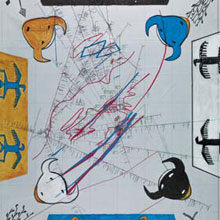
Virginia Pésémapéo Bordeleau, Les cieux,
drawing on mining map,107 x 90,5 cm (detail),
2009, private collection
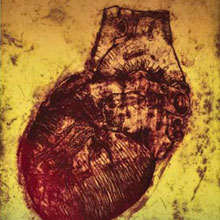
Jasmin Gunn, Karahkwa (Sun),
etching and wood engraving, 56 x 76 cm (detail),
2009, private collection
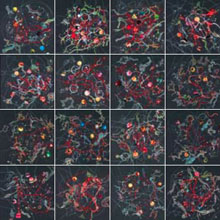
Raymond Dupuis, Kachinas quaqualeum,
polyptic made up of 16 paintings, mixed techniques on cardboard, 25,5 x 25,5 cm (each),
2009, private collection
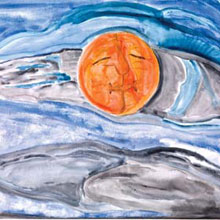
Maude Connolly, Pleine lune de novembre,
watercolour, 45 x 61 cm (detail), 2009,
private collection
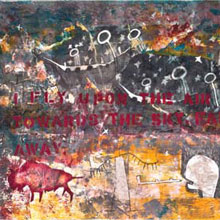
Glenna Matoush, I Fly,
techniques mixtes sur papier, 68 x 110 cm (détail),
2009, collection privée
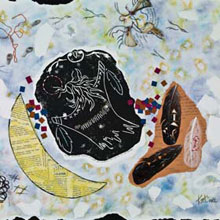
Katia Kurtness, Tepishkau pishum (La lune),
collage on paper, 56 x 74 cm (detail),
2009, private collection
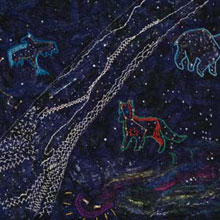
Véronique Thusky, Mikina,
drawing and embroidery on Japanese paper, 60,5 x 84,5 cm (detail),
2009, private collection
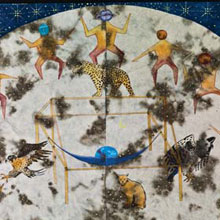
Oswaldo DeLeon Kantule, Nega du (univers),
mixed techniques on handmade paper, 73,8 x 90,3 cm (detail), 2008-2009,
private collection

Denis Charette, Loge des étoiles,
white pine, hickory, cherry wood, copper, acrylic, brass, steel and soapstone, 22,4 x 112 x 37 cm,
2009, private collection
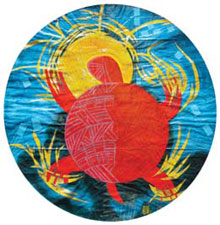
Christine Sioui Wawanoloath, Petite tortue fabrique le soleil,
collage, 74,5 cm (diametre),
2009, private collection
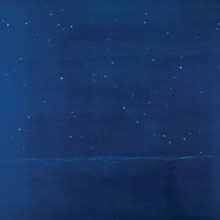
Nadia Myre, Sans titre,
wood engraving, 76 x 91,5 cm, 2009, 1/3,
private collection
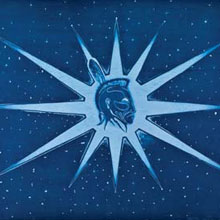
Kyle Bonspille, Sans titre,
wood engraving, [artist proof], 76 x 91,5 cm,
2009, private collection

Felix Jacobson Drolet, Seven dancers,
wood engraving, 76 x 91,5 cm,
2009, private collection/p>
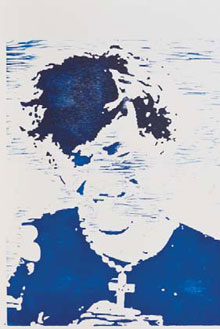
Felix J. Drolet, Me sk isle,
wood engraving, 2009.
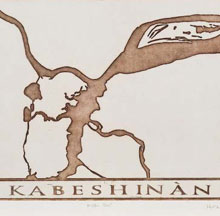
Nadia Myre, Kabeshinan,
etching,, 2008
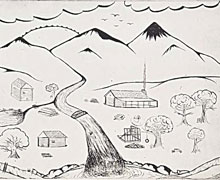
Jason Montour, Scene,
etching,, 2008

Kyle Bonnspille, Sans titre,
etching,, 2009

Nadia Myre, Canoe,
etching,, 2008
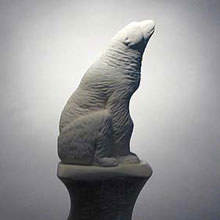
Alec Lawson Tuckatuck, ...Please,
limestone, 2008
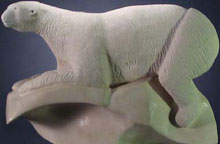
Alec Lawson Tuckatuck, Few and Farbetween,
limestone, 2009.
Cosmogonies of the First Nations
GRANDE BIBLIOTHÈQUE / FROM JUNE 9 TO NOVEMBER 15 FREE ADMISSION
An exhibit curated by Bibliothèque et Archives nationales du Québec and Land InSights on the occasion of First Peoples’ Festival 2009.
Au creux d'une aile noire, charbonneuse, L'astre du jour voyage vers les cieux. Libéré de sa prison de plumes et de l'emprise des montagnes, Le Soleil, ivre de joie, donne naissance à la lumière.
Karine Bertrand
"There lies an immense territory, which calls for a thousand explorations". In this World Astronomy year, these words by Malecite artist Raymond Dupuis resonate in the works of the 14 artists and 8 poets from the First Nations who have followed the trail of the stars, walked on the Milky Way or plunged deep into the very heart of the origins of the Universe. Some of their works provide us the means of seeing and reading a sky where spirits, shamans and hunters dwell. Others offer the vibrant nights of imagined constellations.
The artworks this exhibit offers up are filled with the legends and teachings of an ancestral tradition based on the communication between mortals and the spirit world. The Sun of the Navajos spreads its four skies over a mining map, while the Moon, Grandmother for the Mohawks, takes on the form of a bird and, elsewhere, embroidery thread guides our path between the constellations towards the River of Souls.
A painter and printmaker from the Malecite nation in Quebec, GINETTE AUBIN has created an open body of work, with strong roots in her people's history. The petroglyphs of the ancient ones, which speak so powerfully to today's people as can be seen in the presence of the Micmacs' eight-pointed star in Spécifique de l'univers mi'kmaq/malécite, remain the essential signs of her pictorial language.
Cree artist and author VIRGINIA PÉSÉMAPÉO BORDELEAU has created a sensitive body of work in which family and land, mythical animals, plants and rocks form an organic world, charged with ever-renewed energy. In Les cieux, the spiritual universe of the Navajos unfurled on a mining map opposes deep wisdom to people's mad avidity.
JASMIN GUNN, a Kanesatake Mohawk, got her start in printmaking at the Centre de l'image et de l'estampe de Mirabel. She continued her education in this field at Concordia University. In Karahkwa, a protective sun watches over a heart divided between ancestral wisdom and the teachings of modern technologies.
Malecite painter RAYMOND DUPUIS is a connoisseur of the Hopi pictorial tradition. Like a hallucinating cosmonaut, he takes us on a journey through the stars to the outer limits of his imaginings. Looking closely at the signs he traces on paper, we can see that they draw upon certain petroglyphs from New Mexico, describing the movement of the Sun, the planets and galaxies.
An Innu from Mashteuiatsh, MAUDE CONNOLLY sees creation as a unique and magical means of achieving self-realisation as a human being and artist. In her skilled hands and thanks to her passion for watercolour, her community's cultural legacy is ensured a vibrant future.
GLENNA MATOUSH, a Cree artist of Ojibway origin, creates shamanic work. This time she explores the suffering of souls. The shamans’ raft theme, recurring in her work, returns in I Fly, along with the legend of the woman dressed in a white buffalo hide who came to teach humans the pipe ceremony. In this painting, we see the woman leaving Earth in the form of a buffalo of changing colours, thereby announcing lasting peace for human beings of all origins.
An Innu woman from Lac-Saint-Jean, as she defines herself, painter KATIA KURTNESS takes on the guise of the Moon or Tepiskau pishum, who reigns over the cycle of the seasons. These refer to traditional seasons, corresponding to the key moments in her people’s life, and the seasons of the soul, as we can see from the fragments of her writing that resemble excerpts from a personal diary.
An Anishnabe from Lac-Rapide, VÉRONIQUE THUSKY, who is an artist, storyteller and carrier of knowledge, shows us the sky as it appeared when her father told her the legend of the hunter constellation, pointing his finger towards the North Star. Since then, the night sky has had no secrets for her, as it is peopled with the beings and spirits that are her guides. Although the Anishnabe sky no longer has secrets, it continues to safeguard all its mysteries when the Spirit returns to the River of Souls.
OSWALDO DeLEON KANTULE hails from the Kuna nation in Panama, where he was born on Ustupu island. He stretches out the great hammock of mythology, where Earth, surrounded by protective spirits, can find rest. He traces a faithful portrait of the Kuna universe: Nega Du is a oneiric territory where the stars and planets play the role that Bab Dummad, the Creator, chose for them.
DENIS CHARETTE is an Algonquin Métis from the Outaouais, whose sculptures are signposts marking the Algonquin peoples’ symbolic territories. Each refers to a traditional element of Anishnabe spirituality. By linking his work to Aboriginal cosmogony, the artist, like a shaman, strives to incorporate the wisdom of the ancient ones into the heart of contemporary space.
FIBRES PLANÉTAIRES
Comme un sillon d’aubier printanier
J’ai marqué le cercle sucré
Pour y imprégner célestes univers
Grandissant dans ma fibre planétaire
DENIS CHARETTE
With Petite Tortue fabrique le Soleil (Little Turtle makes the Sun), Abenaki artist CHRISTINE SIOUI WAWANOLOATH reinvents the Big Bang in own way. Her cosmogonic vision, delivered with the blaze of a a lightning bolt, is based on an intimate knowledge of Abenaki mythology and a constant commitment to freeing it from the folklore category to which it has been consigned. In her tales and illustrations, as in her painting and sculpture, the world’s beginning is always here and now.
Multidisciplinary artist NADIA MYRE, of Anishnabe origin, has taken her place as one of the significant figures of contemporary art in Canada. Her critical and conceptual approach provides her works and performances an alloy of strength and vulnerability.
KYLE BONSPILLE, a Mohawk from Kanesatake, learned the printmaking art at Centre de l’image et de l’estampe de Mirabel. His evocation of the Warriors’ flag reminds us that key events in a community little by little become part of its history and a kind of founding myth.
FELIX JACOBSON DROLET, Mohawk from Kanesatake, is an intern at Centre de l’image et de l’estampe de Mirabel. He explores the Iroquoian myth of the Seven Dancers in his work by that name. In modern astronomy, these make up the Pleiades constellation.
Poets
JOSÉPHINE BACON, an Innu, is a filmmaker, lyricist, storyteller and poet. Through the evocative power of words, she takes us across territories and ages. Chloé Sainte-Marie has sung Bacon’s poems. In Spring 2009, the publisher Mémoire d’encrier brought out her book Tshissinuatshitakana – Bâtons à message.
BÂTON À MESSAGE
Mes pas feutrés touchent avec respect cette neige bleue colorée par le ciel
l’étoile de midi me conduit à Papakassiku où m’attend la graisse qui élève le chant de mon héritage quand je pile les os.
JOSÉPHINE BACON
KARINE BERTRAND, of Métis (Anishnabe) origin, grew up on the banks of the Kitchisipi River, in the Outaouais region. She wrote a master’s thesis at University of Ottawa about the depiction of Aboriginals in Quebec documentary cinema. She is also working on a research project about Wapikoni Mobile, a roving video and musical creation studio targeting youth in Aboriginal communities, and the role of cinema as a witness and instrument for cultural arenewal among Quebec Aboriginal peoples.
KIJIK-KISIS (THE SUN)
Au creux d’une aile noire, charbonneuse,
L’astre du jour voyage vers les cieux.
Libéré de sa prison de plumes et de l’emprise des montagnes,
Le Soleil, ivre de joie, donne naissance à la lumière.
NOKOMIS
Parle-moi du mouvement des marées,
Du ventre plein de la femme,
Des grands mystères et du temps
qui passe,
Afin que le ciel nous dévoile
La face cachée de la lumière
et l’ombre-cortège
De sa lune pâle.
LA LUNE RÊVEUSE
Petite lune neigeuse,
Bercée par une pluie de rêves stellaires,
Raconte-nous les jeux de ficelles,
les éclats de rire dans le vent
Et la médecine millénaire
du rêve-étincelle,
Déposée sur l’étang
par un froid matin d’hiver.
LE GRAND NAUFRAGE DES ÉTOILES
Nos mains sont longues et sinueuses,
Mains vides ayant creusé jour après
jour les racines de la terre,
Mains arides constellées par la beauté
frêle des abîmes,
Mains osseuses où l’on peut lire
entre les lignes,
Le récit de notre naufrage et la colère
des dieux-tempêtes.
LA LOGE DES ÉTOILES
Dans le ventre chaud de la mère,
Au coeur de la voûte céleste,
Nous partirons en quête d’une vision,
Armés d’un vaisseau de rêve
et du feu créateur.
WAWATE
Issu de l’âme millénaire
du porteur de lumière,
Un feu de joie aux reflets incandescents
Enlumine le ciel, courtise le néant,
Inspiré par la blancheur-sortilège
d’une étoile-sentinelle.
KARINE BERTRAND
An Innu from Mashteuiatsh, and a traditionalist who is deeply involved in her community, JACINTHE CONNOLLY published a first novel for young readers, L’été de Takwakin in 2002. Her work with troubled youth has had a strong impact on her writing, which she sees as an ideal way to pass down her values.
ATSHIKUSHATSH (LES ÉTOILES)
Elles sont là dans la noirceur
Et dans toute leur grandeur
Tout là-haut dans les hauteurs
Elles prennent la pose pour le grand Illustrateur;
Réconfortent parfois les jeûneurs,
Seraient-elles aussi fournisseuses de kilowattheures
Lorsque je me retrouve dans une quelconque langueur ?
JACINTHE CONNOLLY
MAYA COUSINEAU-MOLLEN, an Innu from the Ekuanitshit (Mingan) community on Quebec’s Lower North Shore, took part in an emerging Aboriginal writers’ residency at the Banff Centre. This experience boosted her career as an artist and writer. She has several writing projects underway, including a story for children and poetry.
HONTE D’ÊTRE
À la honte d’être
Tu lèves pourtant ton verre
Au plus grand génocide
Bassement maquillé
Tes enfants, Utshekataku
Les premières constellations
Cherchant l’identité
Au son hip-hop du tambour
MAYA COUSINEAU MOLLEN
JANVIER 2009
Born in the Ekuanitshit (Mingan) community, RITA MESTOKOSHO was the first Innu poet to publish a book of poems in Quebec, Eshiuapataman Nukum / Comment je perçois la vie, Grand-Mère (1995). Women of her village convinced Mestokosho to become a member of the Ekuanitshit Band Council where she continues to passionately develop cultural and educational projects. She has published her poems in several international reviews and regularly takes part in meetings of writers in indigenous languages and in international literature and poetry festivals. In 2002 a second book of collected poems came out La Mer navigue / La Terre marche / Le Ciel vole / et moi, je rampe pour humer la vie...
NIMUSHUM
Nukum
Tipishkau pishimu
Uashtenamu assinu
Tshetshi uapataman nitinniun
Grand-mère
Astre de la nuit
Éclaire la terre
Pour que je vois ma vie.
RITA MESTOKOSHO
Huwennuwanenhs LOUIS-KARL PICARD-SIOUI, a member of the Wolf Clan of the Wendat people’s Athinye’nonnyahak nation, has lived in Wendake since birth. He has a bachelor’s degree in history/Aboriginal studies and a master’s in Anthropology from Laval University (Quebec City). In 2004, he founded the Wendake Writing Circle alongside the poet Jean Sioui. In 2005, he published a first novel for young readers titled Yawendara et la forêt des Têtes-coupées (Éditions Le Loup de Gouttière).
LE CIEL POURFENDU...
dans les profondeurs de la mer azurée
sourit notre sang, l’écho de nos os
chacun des noms ordonnés
par le reflet des Cieux
inéluctables
Grande-Tortue,
sur ton dos nous demeurons
Enfants du Ciel
LOUIS-KARL PICARD-SIOUI
JEAN SIOUI is a Wendat (Huron) poet. He completed certificates in Aboriginal Studies and Creative Writing at Laval University. His first compilation Le pas de l’Indien was published by éditions Le Loup de Gouttière in 1997. In 2004, he published Poèmes rouges, Hannenorak, a novel for young people. He is cofounder of the Wendake writing circle and facilitates poetry workshops at Centre de développement de la formation et de la main-d’oeuvre huron-wendat (CDFM).
CHEZ NOUS TOUT EST DANS NOS RÊVES
je pagaie dans la course des vents
les vagues nagent en cercle
un huard consulte l’omble
c’est la parole des consciences
un voyage au coeur de l’indien
des soupirs des masques des âmes
des Wendat s’évadent
JEAN SIOUI
SYLVIE-ANNE SIOUI TRUDEL, of Wendat origin, founded the troupe Aataentsic Masques et Théâtre. A special feature of her dramaturgy, which puts a strong emphasis on masks and marionettes, is body language drawing upon elements from traditional Iroquois dances, mime and Japanese theatre.
AATAENTSIC
AMANTE DU MONDE
Aataentsic
étend ses bras
d’étoile en nova
garde un oeil ouvert
sur son droit de veto
Bonne comme la terre
ultime et pleine d’atours
danse avec les âmes
outarde sans détour
SYLVIE-ANNE SIOUI TRUDEL
On the Map: Prints and sculptures
CANADIAN GUILD OF CRAFTS / JUNE 5 TO JUNE 27
Lands joining one another. The links uniting them are imperceptible at first glance. Maps may help in locating them more precisely but what bearing does that have on the relations developed after their encounters?
Borders remain essentially practical markers. From Kanesatake to Mirabel, distance has grown in the detours of history. To get from Kuujjuaraapik to Montreal, the geese are no doubt our best guides. Five First Nations printmakers from the KANESATAKE/CIEM 2009 program and an Inuit sculptor have charted their own universe. They mark their paths and discover an original language as they explore the world of art, opening up a territory that is both intimate and vast, extending from the self to others and from the others to the self. This is how worlds touch one another.
For a second year Centre de l’Image et de l’Estampe de Mirabel (CIEM) welcomes five young people from Kanesatake, invited to map their imaginary landscapes. The techniques of the printmaker’s art become access roads, signposts, exits, and shortcuts or spaces inviting us to take to the open road. The works by Kyle Bonspille, Felix Jacobson Drolet, Dakota Bonspille, Jason Montour and Nadia Myre astonish us by their commitment to taking their place among First Nations culture and traditions. They remind us that the first step provides much of any journey’s meaning.
For Alec Lawson Tuckatuck, a sculptor from Kuujjuaraapik, global warming is a grave threat to the land. His series titled Global Warming Awareness Polar Bears is a call to the people of the South. The dramatic postures of his polar bears balancing on tiny ice floes are evidence of the urgency of opening our eyes and taking action.
CIEM, located in Mirabel provides top quality equipment and instructors to Kanesatake youth, in the framework of a training program. This initiation to traditional print-making techniques and new image technologies concludes with a travelling exhibit.
CIEM is also a production workshop, a vortex of encounters and dissemination and a key centre creating cultural events for all the communities of the Lower Laurentian region.
The ball of the hallucinated carcasses
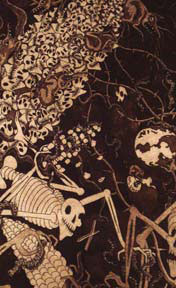

CENTRE CULTUREL SIMÓN BOLÍVAR / FROM JUNE 11 TO 29, 2009
Monday to Friday from noon to 7 pm
Bolívar, 394 W. de Maisonneuve blvd. – Place-des-Arts metro
Prints by Nicolás De Jesús
Born on December 6, 1960 in the Nahua region of the state of Guerrero, in Mexico, Nicolás developed his art in a family setting among the Ameyaltepec community, where the tradition of visual art on amatepaper has flourished for a long time. Nicolás’ work reflects a broad spectrum of personal experiences, from his origins in a traditional village to exile among immigrants transplanted in the USA. Through his prints, Nicolás defends his cultural identity and takes a critical view of planetary reality, through the prism of political tragicomedy. One of Nicolás’ intentions is to raise popular consciousness through art, for liberatory ends, motivating the work he does on murals in Mexico’s Aboriginal communities.
In October 2008, the artist donated this series of prints to the Committee for the Reconstruction of Petanac for fundraising purposes. All sales are earmarked for the reconstruction of this village of the department of Huehuetenango, Guatemala, razed by the Guatemalan army on July 14, 1982 after the massacre of its inhabitants, during an anti-insurrectional and state terrorist campaign.
For further information on the artist and his works:
In French: 514 504-5380
In English: 514 270-7983
www.consulvenemontreal.org
Le rapprochement
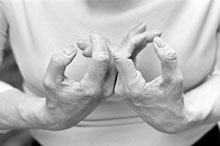
Anne Sioui Trudel’s hands: Sylvie-Anne is a theatrical artist, from the Wendat nation.
Photo: Suzanne Bourdon

Anishinabe dancer: Jerry hunter is a traditional dancer from Lac Simon, representing the Anishnabe nation during a dance competition at the 2008 Kahnawake Pow Wow.
Photo : Suzanne Bourdon
CINÉROBOTHÈQUE LOBBY – NATIONAL FILM BOARD OF CANADA / JUNE 11 TO 21, 2009
1564 St-Denis St., corner de Maisonneuve blvd.
The photo collective Le Rapprochement
Le Rapprochement photo collective brings together four Quebec photographers from different backgrounds, with an aim of spotlighting the work done by First Nations men and women.
Through their different creative paths, these photographs convey an authentic view of local Aboriginal peoples, in order to promote mutual understanding and play a part in fighting prejudice.
Through their own artistic processes, their visits to communities, their own networks of contacts and the people they have met at gatherings and events, the photographers in the collective have built strong connections with many First Nations artists, craftspeople and dancers. Their photos attest to the wealth and vitality of a deeply rooted cultural universe.
The photographers: Suzanne Bourdon, Romain Briard, Paul Brindamour, Ima Zimova
www.collectif-rapprochement.com
Abenaki Women Making Art
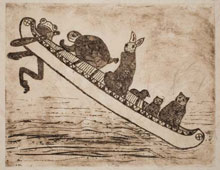
Alanis Obomsawin, Légende,
etching, 2007.
PARK EXTENSION HALL / MAY 15 TO JUNE 21, 2009
421 St. Roch St., Montreal, 514 872-6131
A touring exhibit by Conseil des arts de Montréal
Alanis Obomsawin and Christine Sioui Wawanoloath
Alanis Obomsawin’s prints and Christine Sioui Wawanoloath’s sculptures are integral part of the working memory needed in order to recognize identity and belonging. Borrowiwng from the Abenaki Nation’s main myths on the creation of the world as well as the legends and teachings of their elders, these two artists deliver, in a dazzling synthesis, an enlivening and penetrating portrait of First Peoples today.














